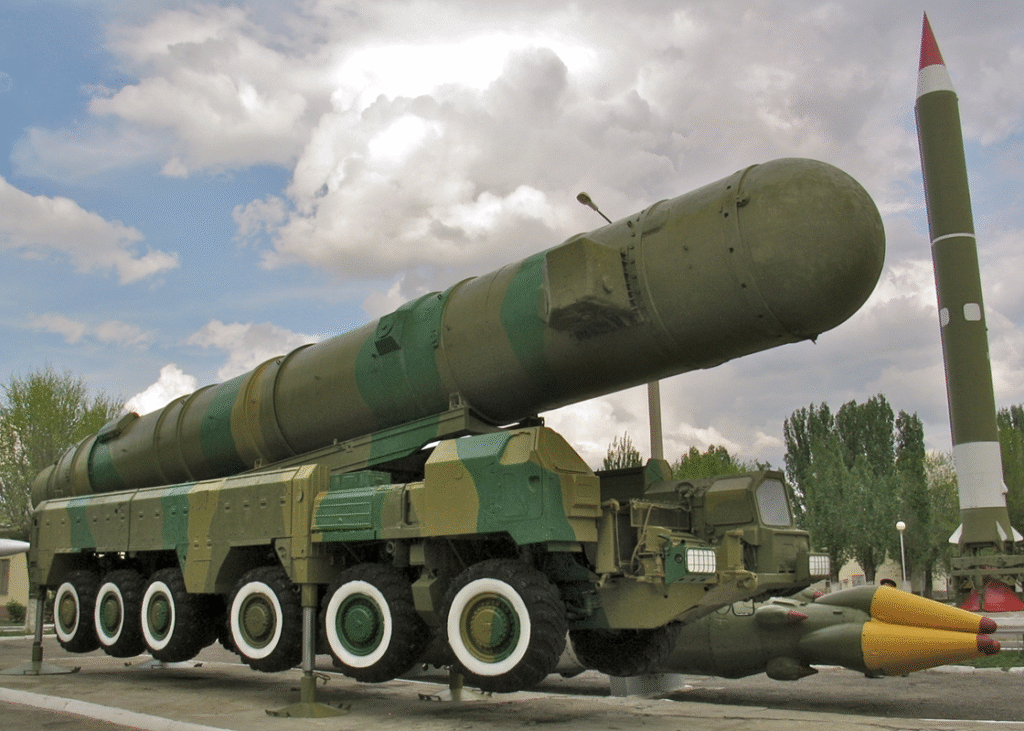In the rapidly evolving arena of modern warfare, where hypersonic weapons, stealth aircraft, and advanced ballistic missiles are reshaping global military strategy, the demand for cutting-edge air defense systems has never been higher. Among the most talked-about advancements is the S-500 Prometey (also known as 55R6M Triumfator-M), Russia’s next-generation surface-to-air missile system. Designed to counter a wide range of aerial threats, including intercontinental ballistic missiles (ICBMs), hypersonic weapons, S-500 Missile System: and even low-orbit satellites, the S-500 represents a significant leap in air defense capability.
This article dives deep into what makes the S-500 a game-changer, how it compares to its predecessors and international rivals, and what its deployment means for global military balance.

A Glimpse into the S-500: What Is It?
The S-500 Prometey, named after the Greek Titan Prometheus, is the latest addition to Russia’s long-standing tradition of advanced missile defense systems. Developed by Almaz-Antey, a major Russian defense contractor, the system is meant to complement S-500 Missile System: and eventually replace the older S-400 Triumf system in Russia’s integrated air defense architecture.
The S-500 is often described as a “space defense” system due to its ability to intercept threats at altitudes of up to 200 kilometers, far above the operational range of most conventional air defense systems. It is intended to protect key strategic assets and urban centers from a broad array of aerial threats — from traditional aircraft to hypersonic missiles S-500 Missile System: and satellites.
Key Features and Capabilities
1. Extended Detection and Engagement Range
The S-500 boasts a detection range of up to 800 kilometers and an engagement range of up to 600 kilometers for aerodynamic targets. When it comes to ballistic targets, it can engage threats at ranges of up to 500 kilometers. This extended range allows the system to detect S-500 Missile System: and respond to threats far before they reach their targets.
2. Multi-Target Tracking and Engagement
The system can track and engage up to 10 ballistic targets simultaneously, even if they are traveling at speeds of up to Mach 20. This makes it capable of dealing with the next generation of fast, maneuverable threats, including hypersonic glide vehicles and stealth aircraft.
3. Anti-Satellite Capabilities
Uniquely, the S-500 is believed to have anti-satellite (ASAT) capabilities, making it not just an air defense system, but a potential tool in space warfare. The ability to target satellites in low Earth orbit (LEO) could provide Russia with a strategic edge in space-based communications S-500 Missile System: and reconnaissance disruption.
4. Advanced Radar and Sensor Suite
The S-500 employs a combination of active electronically scanned array (AESA) radars and phased array radars, which help in tracking multiple targets across various altitudes and trajectories. These sensors can detect stealth aircraft, cruise missiles, and ballistic threats S-500 Missile System: with high precision.
The S-500 Arsenal: Types of Missiles Used
The S-500 is designed to use several types of interceptors, each optimized for different threat profiles:
- 77N6-N and 77N6-N1: These are the new hypersonic interceptors designed to destroy ICBMs and satellites.
- 48N6DM: Also used in the S-400, this missile is capable of intercepting aircraft and cruise missiles.
- 40N6M: A long-range missile with a range of over 400 kilometers.
These missiles are all equipped with hit-to-kill technology, which involves destroying targets by direct impact rather than proximity detonation, greatly increasing kill probability against fast-moving threats.
Development Timeline and Challenges
The development of the S-500 system began in the early 2010s, with a series of delays pushing back its deployment timeline. Initial testing reportedly began around 2016, and the first successful interceptions of ballistic missiles at long range were announced in 2018.
Despite these advancements, the full-scale production and deployment were delayed due to technical challenges, funding constraints, and the complex integration of new technologies. In 2021, Russian officials claimed that the first regiment of S-500 systems had entered service with S-500 Missile System: the Russian Aerospace Forces.
As of 2024, the S-500 is still being gradually introduced into operational units, with full integration into Russia’s national defense expected over the next few years.
Strategic Importance of the S-500
1. Deterrence Against Western Powers
The S-500’s ability to intercept high-speed, long-range missiles and stealth aircraft is seen as a direct counter to NATO air capabilities, especially the U.S. F-22 Raptor, F-35 Lightning II, and upcoming B-21 Raider bomber. Its deployment enhances Russia’s layered air defense S-500 Missile System: and presents a significant deterrent to any potential aerial strike against Russian territory.
2. Protection of Key Strategic Assets
Russia intends to deploy the S-500 primarily around Moscow, nuclear facilities, and military command centers, ensuring that the country’s most vital areas are shielded from even the most sophisticated threats.
3. Space Warfare Edge
With anti-satellite potential, the S-500 places Russia in the league of nations capable of waging warfare in space. This capability could be used to counter satellite-based missile warning systems or GPS infrastructure in a future conflict.

S-500 vs S-400: What’s the Difference?
While both systems are advanced and form part of a multi-layered defense network, there are critical differences between the S-400 and the S-500:
| Feature | S-400 | S-500 |
| Max Engagement Range | 400 km | 600 km |
| Max Altitude | ~30 km | ~200 km |
| Ballistic Missile Defense | Limited | Advanced (up to 500 km) |
| Hypersonic Interception | No | Yes |
| Anti-Satellite | No | Yes |
| Operational Since | 2007 | 2021 (limited deployment) |
Clearly, the S-500 is not a mere upgrade but a complete technological evolution in missile defense.
How It Stacks Up Globally
S-500 vs U.S. THAAD
The U.S. Terminal High Altitude Area Defense (THAAD) system is designed primarily to intercept ballistic missiles during their terminal phase. While THAAD excels in missile defense, it lacks the versatility of the S-500 in engaging multiple types of aerial threats including stealth aircraft S-500 Missile System: and low-orbit satellites.
S-500 vs Aegis BMD
The Aegis Ballistic Missile Defense system is sea-based and features SM-3 interceptors capable of targeting intermediate-range ballistic missiles and satellites. Though powerful, the Aegis system is dependent on naval deployment, while the S-500 provides land-based strategic defense, particularly around urban and military installations.
S-500 vs China’s HQ-19
China’s HQ-19 is often considered the Chinese equivalent of THAAD. It is still under development and testing, and while promising, lacks the confirmed multi-layered capabilities of the S-500. China is also developing the HQ-26, which may eventually rival the S-500, but for now, Russia appears to hold a lead in integrated space S-500 Missile System: and missile defense.
Potential for Export and Geopolitical Ramifications
Despite its advanced features, Russia has signaled caution in exporting the S-500 system. Unlike the S-400, which has been sold to countries like Turkey and India, the S-500 is considered strategically sensitive and crucial to national defense. However, there have been indications that allies such as China and India might be future customers once the system is fully deployed within Russia.
This selective export policy could reshape military alliances, especially if countries looking for high-end air defense systems feel constrained by U.S. arms sales restrictions or are seeking to diversify their defense suppliers.
Criticisms and Limitations
While the S-500 is a technological marvel, it’s not without criticism:
- Cost: The advanced sensors, missiles, and support systems make it extremely expensive to produce and maintain.
- Mobility: While it is technically mobile, its complex setup and size reduce its ability to be rapidly repositioned compared to shorter-range systems.
- Operational Readiness: As of now, only limited numbers have been deployed. Its full effectiveness in combat scenarios remains untested.
The Future of Air Defense: What Comes Next?
As nations continue to develop hypersonic glide vehicles, stealth UAVs, and space-based weaponry, the role of systems like the S-500 will become more prominent. Its development signals a shift toward integrated defense ecosystems that can operate across all domains — land, air, S-500 Missile System: and space.
Russia is already rumored to be working on the S-550, which may push the boundaries even further, potentially with autonomous AI capabilities and global strike intercept options.
Conclusion
The S-500 Prometey represents a significant leap in missile defense technology, giving Russia a potent tool to safeguard its airspace and strategic assets against both current and future threats. With its broad engagement range, hypersonic and anti-satellite capabilities, and advanced radar systems, the S-500 is more than just a successor to the S-400 — it’s a glimpse into the future of modern warfare.
As global tensions escalate and the race for missile supremacy continues, systems like the S-500 will likely play a central role in determining the balance of power, not just on Earth, but possibly in space as well.
Read more https://magazinesnove.com/s-400-unraveling-the-power-and-politics/


